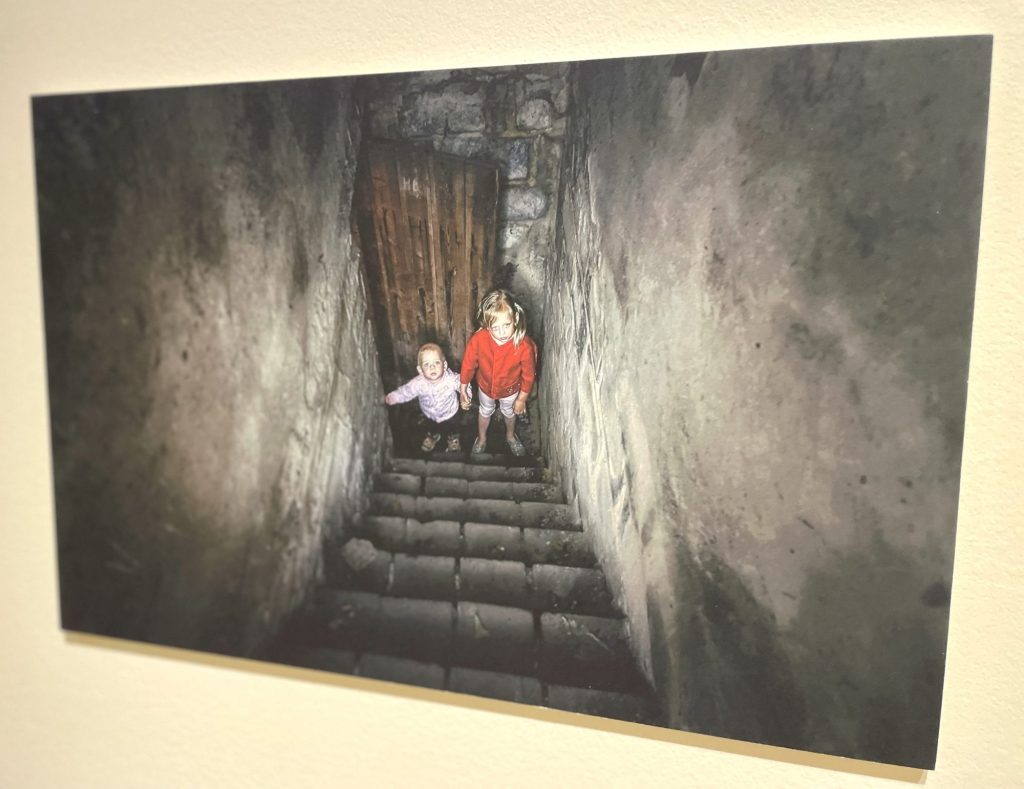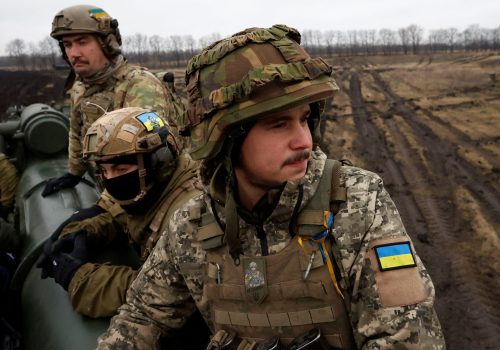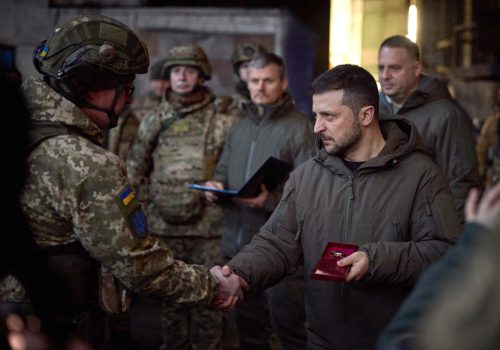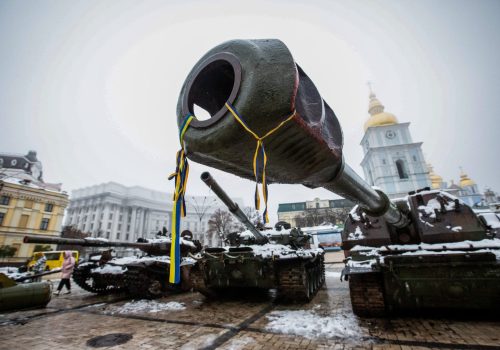Here we go again. An art heist rivaling the plunder of the Nazis during World War II is taking place right now in Europe. Since its full-scale invasion of Ukraine began in February 2022, Russia has pillaged over 30 museums, stealing thousands of precious objects from oil paintings to ancient artifacts.
These thefts, as the New York Times recently reported, are not isolated episodes, but part of a wider and premediated effort by Russian President Vladimir Putin to destroy the culture of Ukraine. This is an aspiration that Moscow has repeatedly tried and failed to fulfill over the past several centuries.
“Women at War,” a new US exhibition featuring a variety of works by twelve female Ukrainian artists, is a symbol of defiance to the Kremlin’s latest attempt to expunge Ukraine’s heritage. Though a number of the artists featured in the exhibition have fled to Europe or America since the full-scale invasion began, all of the works on show were originally crafted in Ukraine itself.
Curated by Monika Fabijanska at the Fridman Gallery in New York, the exhibition demonstrates that, in contrast to Russian imperial dreams, a thriving and independent Ukrainian artistic tradition exists. Indeed, as Fabijanksa has observed, “[Ukrainian artists] have their own culture and dreams and, often, that dream is about independence and about an identity that is their own, without the threat of annexation, invasion, and annihilation.”
Stay updated
As the world watches the Russian invasion of Ukraine unfold, UkraineAlert delivers the best Atlantic Council expert insight and analysis on Ukraine twice a week directly to your inbox.
This exhibition has now traveled to the Stanford in Washington Gallery, where American Purpose, an intellectually engaging online magazine devoted to covering politics and culture, held a reception on January 12 welcoming its arrival. Opening remarks from several speakers including the historian Sonya Michel, who saw the exhibition in New York and helped bring it to Washington, testified to its ability to bring home the daily indignities, humiliations, and horrors of the war. “Women at War” will remain at the Stanford in Washington campus until March 22.
The exhibition, which includes a seven-minute film by Oksana Chepelyk that is titled “Letter from Ukraine,” features various artworks ranging from cartoons of the hellishness of daily life in the Donbas to a superb life-size oil painting on canvas by Lesia Khomenko called “Max in the Army.” The solitary and solemn uniformed Max, himself an artist and the husband of Khomenko, is shown saluting and staring into the distance, offering a poignant reminder of the isolation that can accompany heading off to join the army. Was Khomenko saying farewell to him as much as he was to her?
Several drawings depict rape victims of Russian soldiers. Wrestling with such depravity could not have come easily. Dana Kavelina, who was born in 1995 in Melitopol and now lives in Germany as a refugee, took this challenging subject up in a series of searing drawings called “Communications. Exit to the Blind Spot.” She not only addresses the vile actions of Russian soldiers in Ukraine but also the “rape camps” established by the Serbs in Bosnia and Herzegovina during the 1990s. The drawings are never less than harrowing. One, for example, features blood spooling from several women’s bodies and men depicted with red hands. These women, as the exhibition notes, were “purposefully destroyed by repeated rapes,” but Kavelina is searching for a way to bring “subjectivity” to these victims and to bear witness to their anguish.
Eurasia Center events

Perhaps the most significant piece in the exhibition required the least overt artistry. A white linen sheet hangs at the entrance with a poem written on it in felt pen:
“May you choke on my soil.
May you poison yourself with my air.
May you drown in my waters.
May you burn in my sunlight.
May you stay restless all day and all night.
And may you be afraid every second.”
Olia Fedorova wrote these words while Russian forces besieged her home city Kharkiv in March 2022. Her text reflects the feelings of ordinary Ukrainians caught up in the horrors of Russia’s invasion. She captures the rage, helplessness, and flinty determination that outsiders can only begin to comprehend when they see the mass graves in Bucha, the hundreds of destroyed cars piled high outside Irpin, or the viral video of one girl’s birthday party in her bright yellow family kitchen just before it was destroyed by a Russian missile.
The exhibition also shines in detailing the hardships of everyday life since Moscow’s illegal annexation of Crimea in 2014 and establishment of puppet regimes in eastern Ukraine. In this regard, a series of 12 cartoon drawings by Aleutina Kakhidze is very instructive indeed. She vividly depicts the journey her elderly mother had to make to collect her paltry pension. We learn that it took her up to eleven-and-a-half hours to cross numerous military borders, with endless delays and no predictability. In the final picture, her mother’s heart gives out as she waits for her pension to be processed. While shocking, the outcome is all too common as senior citizens were often forced to stand in long lines.
The tone of the exhibition is not always grim. Consider the series of photographs by Yevgenia Belorutets entitled “Victories of the Defeated.” Her marvelously evocative four photographs introduce us to the ordinary beauty of daily life in post-industrial Ukraine in spite of all the hardships. Covered in coal soot and outfitted in large gloves and an ill-fitting jacket, one woman in a blue stocking cap stares knowingly at the camera while the female subjects in two others smile broadly and even laugh.
Far from cowering before Putin and his thugs, Ukrainians remain defiantly triumphant. As Zhanna Kadyrova explains in an accompanying note that she composed in March 2022, passivity in the face of terror is not an option. “For the first two weeks of the war, it seemed to me that art was a dream, that all twenty years of my professional life were just something I had seen while asleep, that art was absolutely powerless and ephemeral in comparison to the merciless military machine destroying peaceful cities and human lives. I no longer think so: I see that every artistic gesture makes us visible and makes our voices heard!” Yes, they do. Both the Stanford in Washington Gallery and American Purpose deserve plaudits for helping to ensure that the efforts of Ukrainian artists to thwart Russian tyranny attract the attention they so abundantly merit.
Jacob Heilbrunn is the editor of the National Interest and Melinda Haring is the director of stakeholder relations and social impact at the Superhumans Center in Ukraine. Both Heilbrunn and Haring are non-resident senior fellows at the Atlantic Council’s Eurasia Center.
Further reading
The views expressed in UkraineAlert are solely those of the authors and do not necessarily reflect the views of the Atlantic Council, its staff, or its supporters.

The Eurasia Center’s mission is to enhance transatlantic cooperation in promoting stability, democratic values and prosperity in Eurasia, from Eastern Europe and Turkey in the West to the Caucasus, Russia and Central Asia in the East.
Follow us on social media
and support our work
Image: Photo from the “Women at War” exhibition featuring a variety of works by twelve female Ukrainian artists.




